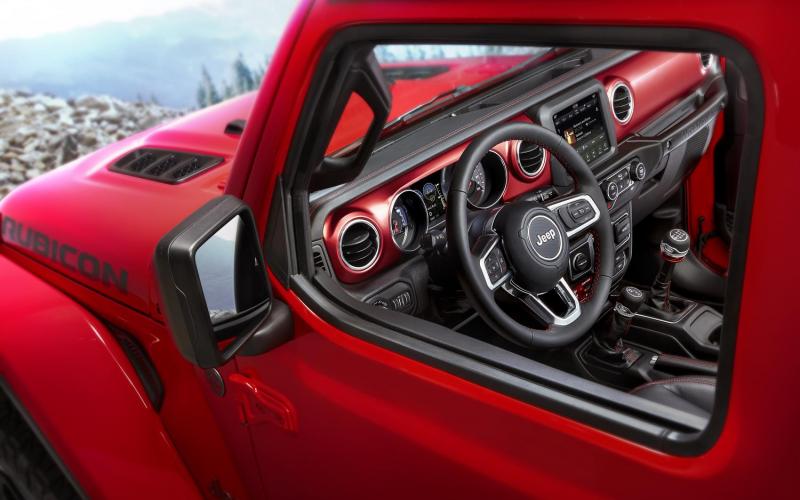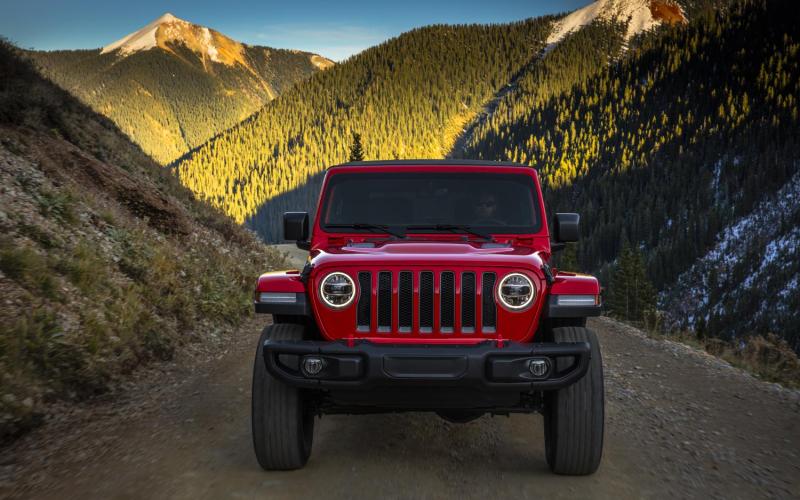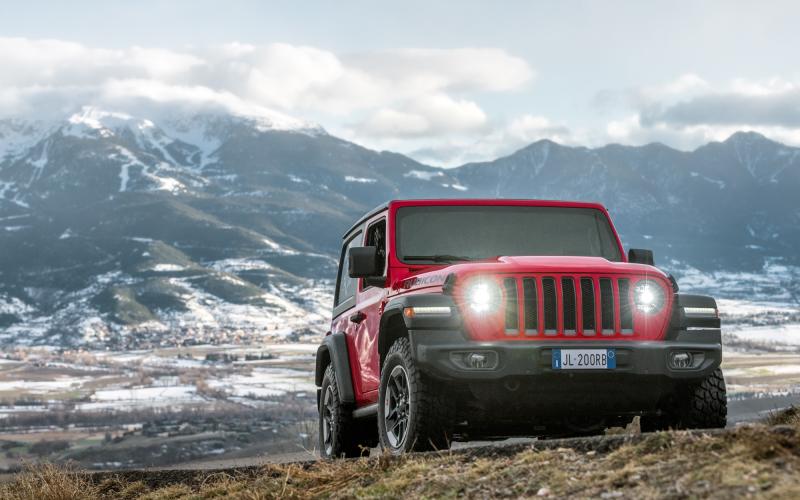The Best Wrangler Ever
First featured in 4x4 magazine, October 2018
Jeep is making no bones about it: the new Wrangler is the best off-roader it’s ever made. But as Britain prepares for its arrival this September, can the new JL model do enough to justify what’s going to be a hefty price tag?
This is the big one. The off-road world has been waiting for a long time for the new Jeep Wrangler – and come September, at long last you’ll be able to buy one.
You really will be able to buy one, too, if Jeep stays true to its promise that it will make more room on the production line for right-hand drive Wranglers.This should mean the endless supply issues that seemed to dog the outgoing model will now be a thing of the past.
The new Wrangler remains a traditional off- road machine in every way, with a ladder chassis, beam axles and a separate two-speed transfer box controlled by a manual lever. Despite this, it’s a lot lighter than before, and while it looks similar to the old one it’s different in a whole host of ways.
Under the bonnet, for example, you’ll now find a choice of 2.2-litre diesel and 2.0-litre petrol engines. Both are turbocharged, and both are mated exclusively to an eight-speed auto box – there’s no longer going to be such a thing as a manual Wrangler.
A major improvement over the old model, however, is that the transfer case will allow you to run in four-wheel drive on the road.The new Selec-Trac unit has two 4H positions, with and without a locked centre diff, in addition to the usual 2H and 4L options.
Something else we’ve been longing for is a diesel version of the Rubicon model. This is the Wrangler in hardcore off-road form, with deeper low-range transfer gears, rock rails, heavy-duty Dana 44 axles, locking front and rear diffs and a disconnecting front anti-roll bar to aid articulation.
In the previous Wrangler, the Rubicon was only ever available with a big petrol engine. People were forever crying out for a diesel option; Jeep did offer this in LHD markets, but in the UK we’ve had to wait for it until now.
The Rubicon takes its place in a model line-up which encompassing four spec levels and two wheelbases in addition to the choice of engines. For ‘everyday’ Wrangler buyers, there’ll be the familiar Sport and Sahara trim lines, augmented on the latter by an optional Overland styling pack.This is aimed at image-conscious buyers who want to make it as luxurious as possible.
We drove a variety of models on the launch, starting with a Sahara Overland – whose interior was enough to make it obvious that Jeep has raised its game with the Wrangler.The dash design is extremely good – it’s still as upright
as ever, but the materials and styling are very appealing and the layout of the dials and controls, with a sizeable media screen dominating the upper part of the facia, does a fine job of making you feel in charge.
So too does a traditionally upright seating position, which gives you a suitably towering view of the road ahead. You have to crane to see the front corners, as the sweeping curve of the bonnet obscures your view of the wheelarches, but visibility is otherwise excellent. The seats are comfortable, too, though in typical Wrangler style there’s very little room between them and the door next to you, so adjusting your position won’t be the easiest of tasks if you have big hands.
We can’t yet comment on space in the rear seats, however the three-door model is very short on luggage room while the five-door has lots. No change there, then.
But there is a change on the road, and it’s a change for the better. The previous Wrangler was pretty truck-like here, but the new model rides with what is, by the standards of a traditional off- road machine, remarkable composure.
The launch took place in Austria, in an area where the roads appear to be almost completely lacking in imperfections. So the Wrangler will still have something to prove back on the scrappy surfaces of Britain. But the Overland and Rubicon models alike glided along with no sign of harshness or vibrations – and in the latter case, that was on mud-terrain tyres, too.
Handling is never going to be a strong point for an off-road machine, but the advent of full-time four-wheel drive means a new level of grip on the road. Previous Wranglers have been tail-happy customers in the wet, which can be pretty hilarious but doesn’t fill you with confidence when you’re trying not to hold up traffic on the open road; with this model, once you’re used to the way it steers you’ll be able to chuck it around to your heart’s content.
To aid you in this, the 2.2-litre diesel engine pulls pretty well. It’s the only one we’ve driven thus far; it doles out 200bhp and 332lbf.ft, the latter from 2000rpm, so there’s no shortage of get up and go, and it feels strong throughout without ever raising its voice enough to disturb the peace. On that subject, even at a fast cruise on the autobahn we were able to hold a normal conversation without any intrusive wind or road noise to get in the way.
At present, projected economy figures with the diesel engine are in the 35-38mpg bracket, with emissions ranging from 195-209g/km.
We’re yet to hear what the petrol unit returns, however it’s usefully more powerful with 272bhp at 5250rpm. Torque is down a little on the diesel at 295lbf.ft at 3000rpm, however, so we know which one most people will go for.
Whichever engine you choose, a major disappointment for a significant number of 4x4 drivers will be the Wrangler’s rated towing limit. The three-door can pull up to 1495kg, with the five-door taking this up to 2495kg. Farmers will have stopped reading here. It’s not obvious why this is, when the previous five-door model was able to pull 3500kg when it first came to Britain, but it reinforces the common perception of the Wrangler, which Jeep itself admits to sharing, as a big boy’s toy rather than a working tool.
Bearing this in mind, first impressions continue to be of a Wrangler that’s still every inch a Wrangler – but far better inside and far, far better on the road. Which, literally, leads us to the main event.
The off-roading we were given the opportunity to do on the launch was basically a combination of Cat A forest tracks and green roads whose surfaces were at times moderately rutted or pock-marked with exposed tree roots. It certainly wasn’t bountiful in its traction but, had our Rubicon’s mud-terrains failed to take it at a stroll, something would have been badly wrong.
There were no rocks of any kind, though, nor anything to require using the vehicle’s diff- locks. Aside from a few moderate axle-twisters, moreover, the suspension was never put to a meaningful test.
To put it another way, the Rubicon was totally untroubled by what was a fair indication of the off-roading it might be asked to do on a fairly gentle green lane run. As it should be.
One thing the experience did prove is that the automatic gearbox performs admirably on steep terrain. Knocked into low first, it behaved exactly as a manual would, holding the vehicle at a controlled crawl; the Wrangler doesn’t have hill descent control, and this box demonstrated that even with an auto, fancy electronics like that shouldn’t be necessary.
To some extent, the Wrangler has nothing to prove here. The JK was brilliant off-road and we always knew the JL would be too. It’s on the road that it needed a great leap forward, and thus far that’s what it looks to have done.
Sadly, something else that is looking to have made a great leap forward is what the Wrangler will cost. UK specs and prices are some way from being finalised, however a Jeep spokesman told us that the entry-level three-door Sport model is going to cost €48,000 in Italy. Translate that into sterling, and it suggests that we’ll be paying from somewhere in the mid-£40k region when the vehicle goes on sale here. At the very best, it’s looking like at least a 10% hike over the outgoing model – and by the time you get up to the five- door Rubicon, we expect it to be into the fifties.
So that’s something like two and a half times more expensive than the JK was when it was launched in 2007, which shows a certain amount of confidence on Jeep’s part. Given the enormous demand there was for the JK, it’s a confidence that’s probably justified – but we’d imagine there are plenty of people reading this who’ve been ready and waiting for Jeep to convince them not to order that Ranger after all, but who are looking up their local Ford dealer even as we speak...
High prices never stopped Jeep from selling all the Wranglers it can bring in before, however. And now the Wrangler is looking a great deal better than ever, and more suitable as an all-round everyday car, they’re easier to justify. It’s
a lot of money – but you’ll get an awful lot of off-road ability for it.
You get a true off-road icon, too. And we all know how few of those there are to choose from these days. Safe to say, the Wrangler is back.





















